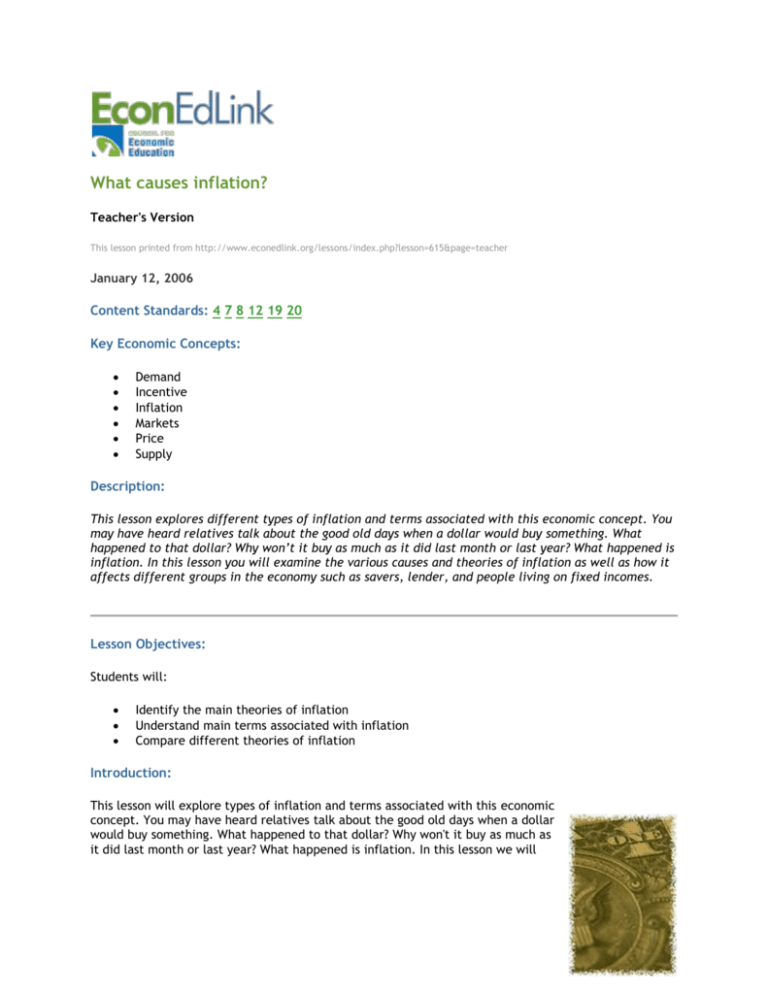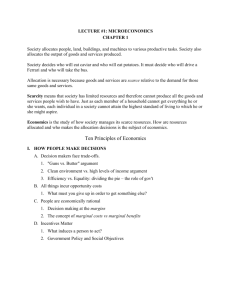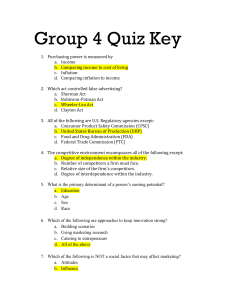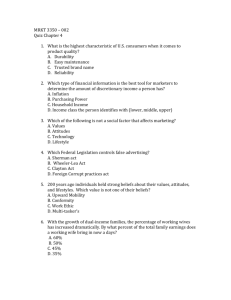
What causes inflation?
Teacher's Version
This lesson printed from http://www.econedlink.org/lessons/index.php?lesson=615&page=teacher
January 12, 2006
Content Standards: 4 7 8 12 19 20
Key Economic Concepts:
Demand
Incentive
Inflation
Markets
Price
Supply
Description:
This lesson explores different types of inflation and terms associated with this economic concept. You
may have heard relatives talk about the good old days when a dollar would buy something. What
happened to that dollar? Why won’t it buy as much as it did last month or last year? What happened is
inflation. In this lesson you will examine the various causes and theories of inflation as well as how it
affects different groups in the economy such as savers, lender, and people living on fixed incomes.
Lesson Objectives:
Students will:
Identify the main theories of inflation
Understand main terms associated with inflation
Compare different theories of inflation
Introduction:
This lesson will explore types of inflation and terms associated with this economic
concept. You may have heard relatives talk about the good old days when a dollar
would buy something. What happened to that dollar? Why won't it buy as much as
it did last month or last year? What happened is inflation. In this lesson we will
examine the various causes and theories of inflation as well as who is responsible for tracking it.
You may want to use the lessons below before starting this lesson. They will provide students with
proper background information on inflation and the CPI.
www.econedlink.org/lessons/index.php?lesson=EM255&page=teacher
www.econedlink.org/lessons/index.php?lesson=EM227&page=teacher
Resources:
"Inflation" is available at:
www.socialstudiesforkids.com/articles/economics/inflation1.htm
[1]
"What Goods and Services Does CPI Cover" is available at:
www.bls.gov/cpi/cpifaq.htm#Question_7 [2]
"Theory 1 - Demand-pull inflation - is inflation demanding?" is available at:
www.bized.co.uk/virtual/bank/economics/mpol/inflation/causes/theories1.htm
"Theory 2 - Cost-push inflation - is inflation pushy?" is available at:
www.bized.co.uk/virtual/bank/economics/mpol/inflation/causes/theories2.htm
[3]
[4]
"Theory 3 - Quantity theory of money - in theory what quantity would you like?" is available at:
www.bized.co.uk/virtual/bank/economics/mpol/inflation/causes/theories3.htm [5]
Process:
Use the following slide show presentation to introduce the various causes of inflation.
Causes of Inflation Slide show
Next, provide the students with copies of these two study guides: Study Guide #1 and Study Guide #2.
Teachers' versions of the study guides are provided here: Teacher Study Guide #1 and Teacher Study
Guide #2.
To complete study guide #1, the students will need to read this Web site:
www.socialstudiesforkids.com/articles/economics/inflation1.htm [1]
To complete study guide #2, the students will need to read these Web sites:
Part #1: www.bls.gov/cpi/cpifaq.htm#Question_7
[2]
.
Part #2: www.bized.co.uk/virtual/bank/economics/mpol/inflation/causes/theories1.htm
[3]
.
Part #3: www.bized.co.uk/virtual/bank/economics/mpol/inflation/causes/theories2.htm
[4]
.
Part #4: www.bized.co.uk/virtual/bank/economics/mpol/inflation/causes/theories3.htm
[5]
.
Conclusion:
Inflation has remained in check for much of the past three decades. As a result,
prices of goods and services have remained relatively steady. However, we must
be on the lookout for factors that can lead to periods of high inflation. Prices of
goods and services will rise. The rise may be caused by demand exceeding
supply, or because the cost of making goods and services rises and that cost gets
passed on to the consumer, or because it may be that there is too much money
in the economy. Whatever the reason, or combination of reasons, we can expect
some inflation in our economy.
Assessment Activity:
Online Assessment Activity
Here are the questions that will appear on the Online Assessment Activity.
1. According to the Quantity Theory:
a. Inflation occurs because there is not enough money in the economy.
b. Inflation occurs because demand exceeds supply for goods and services.
c. [Inflation occurs because there is too much money in the economy.]
2. The cost-push theory of inflation states that:
a. Inflation occurs because there is not enough money in the economy.
b. [Inflation occurs because the costs of producing goods and services go up and are then
passed along to the consumer.]
c. Inflation occurs because there is too much money in the economy.
3. Which of the following best describes the demand-pull theory of inflation?
a. [Inflation occurs because demand exceeds supply for goods and services.]
b. Inflation occurs because the costs of producing goods and services go up and are then passed
along to the consumer.
c. Inflation occurs because there is too much money in the economy.
4. Purchasing power describes what happens to our ability to buy goods and services when
prices...
a. fall due to inflation.
b. [rise due to inflation.]
c. rise due to deflation.
5. True or False? The market basket is a combination of goods and services that the BLS uses to
track changes in the general price level. These are items that an average family will spend
money on in a given month.
a. [True]
b. False
Extension Activity:
Assign the students to write an essay comparing and contrasting the causes of inflation. In their essays,
the students should use the information they used to complete the process section.
Answers will vary:
Students should provide an analysis of the various types of inflation and theories behind them.
Links Used:
1. ^ ^ "www.socialstudiesforkids.com/articles/economics/inflation1.htm" (www.socialstudiesforkids.com)
2. ^ ^ "www.bls.gov/cpi/cpifaq.htm#Question_7" - (www.bls.gov)
3. ^ ^ "www.bized.co.uk/virtual/bank/economics/mpol/inflation/causes/theories1.htm" -
(www.bized.co.uk)
4. ^ ^ "www.bized.co.uk/virtual/bank/economics/mpol/inflation/causes/theories2.htm" (www.bized.co.uk)
5. ^ ^ "www.bized.co.uk/virtual/bank/economics/mpol/inflation/causes/theories3.htm" (www.bized.co.uk)
Council for Economic Education
Copyright © 2010 Council for Economic Education. All rights reserved.







